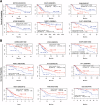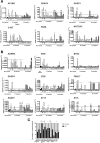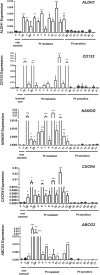New markers for human ovarian cancer that link platinum resistance to the cancer stem cell phenotype and define new therapeutic combinations and diagnostic tools
- PMID: 31159852
- PMCID: PMC6547556
- DOI: 10.1186/s13046-019-1245-5
New markers for human ovarian cancer that link platinum resistance to the cancer stem cell phenotype and define new therapeutic combinations and diagnostic tools
Abstract
Background: Ovarian cancer is the leading cause of gynecologic cancer-related death, due in part to a late diagnosis and a high rate of recurrence. Primary and acquired platinum resistance is related to a low response probability to subsequent lines of treatment and to a poor survival. Therefore, a comprehensive understanding of the mechanisms that drive platinum resistance is urgently needed.
Methods: We used bioinformatics analysis of public databases and RT-qPCR to quantitate the relative gene expression profiles of ovarian tumors. Many of the dysregulated genes were cancer stem cell (CSC) factors, and we analyzed its relation to therapeutic resistance in human primary tumors. We also performed clustering and in vitro analyses of therapy cytotoxicity in tumorspheres.
Results: Using bioinformatics analysis, we identified transcriptional targets that are common endpoints of genetic alterations linked to platinum resistance in ovarian tumors. Most of these genes are grouped into 4 main clusters related to the CSC phenotype, including the DNA damage, Notch and C-KIT/MAPK/MEK pathways. The relative expression of these genes, either alone or in combination, is related to prognosis and provide a connection between platinum resistance and the CSC phenotype. However, the expression of the CSC-related markers was heterogeneous in the resistant tumors, most likely because there were different CSC pools. Furthermore, our in vitro results showed that the inhibition of the CSC-related targets lying at the intersection of the DNA damage, Notch and C-KIT/MAPK/MEK pathways sensitize CSC-enriched tumorspheres to platinum therapies, suggesting a new option for the treatment of patients with platinum-resistant ovarian cancer.
Conclusions: The current study presents a new approach to target the physiology of resistant ovarian tumor cells through the identification of core biomarkers. We hypothesize that the identified mutations confer platinum resistance by converging to activate a few pathways and to induce the expression of a few common, measurable and targetable essential genes. These pathways include the DNA damage, Notch and C-KIT/MAPK/MEK pathways. Finally, the combined inhibition of one of these pathways with platinum treatment increases the sensitivity of CSC-enriched tumorspheres to low doses of platinum, suggesting a new treatment for ovarian cancer.
Keywords: Biomarkers; Cancer stem cells; Ovarian cancer; Therapy.
Conflict of interest statement
The authors declare that they have no competing interests.
Figures





References
-
- Pignata S, Scambia G, Ferrandina G, Savarese A, Sorio R, Breda E, et al. Carboplatin plus paclitaxel versus carboplatin plus pegylated liposomal doxorubicin as first-line treatment for patients with ovarian cancer: the MITO-2 randomized phase III trial. J Clin Oncol. 2011;29(27):3628–3635. doi: 10.1200/JCO.2010.33.8566. - DOI - PubMed

